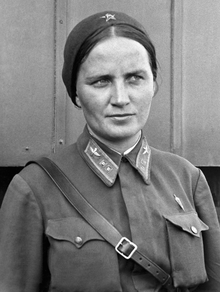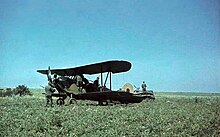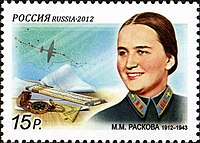|
Marina Raskova
Marina Mikhaylovna Raskova (Russian: Мари́на Миха́йловна Раско́ва, IPA: [mɐˈrʲinə mʲɪˈxajləvnə rɐˈskovə]; née Malinina; 28 March 1912 – 4 January 1943) was the first woman in the Soviet Union to achieve the diploma of professional air navigator. Raskova went from a young woman with aspirations of becoming an opera singer to a military instructor to the Soviet's first female navigator. She was the navigator to many record-setting as well as record-breaking flights and the founding and commanding officer of the 587th Bomber Aviation Regiment, which was renamed the 125th M.M. Raskova Borisov Guards Dive Bomber Regiment in her honor. Raskova became one of over 800,000 women in the military service, founding three female air regiments, one of which eventually flew over 30,000[1] sorties in World War II and produced at least 30 Heroes of the Soviet Union.[2] Early lifeMarina Malinina was born to middle-class parents. Her father was operatic singer and singing instructor Mikhail Malinin (Михаил Дмитриевич Малинин) and her mother a teacher. Anna Lyubatovich, her mother's sister, was a known Russian singer as Tatyana Lyubatovich (Татьяна Спиридоновна Любатович). Her half-brother (through her father) was shipbuilding scientist Boris Malinin. Unlike the majority of Soviet airwomen,[3] Marina did not show any early interest in aviation.[4] Becoming a pilot-navigator was her second choice. Raskova had originally wanted to become a musician,[3] and her goal was to become an opera singer. In 1919, when she was seven, her father died from the injuries inflicted when he was struck by a motorcycle.[3] She continued her drama and singing studies, but later she fell victim to a middle ear infection that left her unable to continue singing. She decided to quit music and to devote herself to studying chemistry and engineering in high school. After graduation in 1929, to help her family, she started work in a dye factory as a chemist. She married an engineer, Sergey Raskov, whom she met at the dye factory, so changing her name to Raskova. She had a child, Tanya, in 1930. The following year she started to work in the Aero Navigation Laboratory of the Air Force Academy as a draftswoman.[4] Raskova became a famous aviator as both a pilot and a navigator for the Soviet Union in the 1930s. She was the first woman to become a navigator in the Soviet Air Force in 1933.[5] A year later, she started teaching at the Zhukovsky Air Academy, also a first for a woman. She taught male and later, female students military navigation. She was the subject of skepticism by many of her male students but was able to prove herself capable. Later, the Academy sent Raskova to Tushino for the Central Flying Club in order to receive flying lessons, which she completed in August 1935. When Raskova's training ended, she was able to become an instrument flying instructor and was allowed to teach command personnel advanced navigation. In 1935, she divorced.[4] She set a number of long-distance records, a significant achievement in the eyes of the Soviet Union, which gave its aviators celebrity status. Most of these record flights occurred in 1937 and 1938, while she was still teaching at the air academy. She was referred to as the "Russian Amelia Earhart" for her achievements. The most famous of her long-distance records was the flight of the Rodina (Russian for "Motherland"), Ant-37 – a converted DB-2 long range bomber – on 24–25 September 1938. She was the navigator of the crew that also included Polina Osipenko and Valentina Grizodubova. From the start, the goal was to set an international women's record for a straight-line distance flight. The plan was to fly from Moscow to Komsomolsk (in the Far East). When finally completed, the flight took 26 hours and 29 minutes, over a straight-line distance of 5,947 km (3,695 mi) (total distance of 6,450 km (4,010 mi)). However, the ordeal took 10 days when the plane was unable to find an airfield due to poor visibility. Because the navigator's cockpit had no entrance to the rest of the plane and was vulnerable in a crash landing, Raskova parachuted out before they touched down. She had forgotten her emergency kit and was unable to find the plane for 10 days, with no water and almost no food. The rescue crew had found the aircraft eight days after the landing, and was waiting when she found her way to it, after which all three women were taken to safety. On 2 November 1938, all three women were decorated with the Hero of the Soviet Union award, the first females ever to receive it and the only ones before World War II.[6] World War IIWhen World War II broke out, there were numerous women who had training as pilots and many immediately volunteered. While there were no formal restrictions on women serving in combat roles, their applications tended to be blocked, run into red tape, etc. for as long as possible in order to discourage the applicants from entering any training program.[7] Raskova is credited with having used her personal connections with Joseph Stalin to convince the military to form three combat regiments of women. Following a speech by Raskova on 8 September 1941 calling for women pilots to be allowed to fight, Stalin on 8 October 1941 ordered the formation of the all-female 122nd Aviation Corps.[8] Not only would the women be pilots, but also support staff and engineers. After their training, the Group's three regiments received their formal designations as follows:
 Raskova died on 4 January 1943, when her aircraft crashed attempting to make a forced landing on the Volga bank, while leading two other Pe-2s to the first operative airfield near Stalingrad. The entire crew perished.[4] She received the first state funeral of the war.[14] LegacyHer ashes were buried in the Kremlin Wall Necropolis on Red Square, beside Polina Osipenko's. She was posthumously awarded the Order of the Patriotic War I Class.[15] An American ship, Ironclad (launched as Mystic in April 1919), that had taken part in Convoy PQ 17 was transferred to Soviet ownership and renamed Marina Raskova in June 1943. Streets were named after her in Moscow and Kazan, as well as a square in Moscow, some schools and Young Pioneer detachments.[16] There was a bust of her at the "M. M. Raskova" Higher Military Aviation School of Pilots in Tambov, but that school ceased to function in 1997.[17]  In philately
See also
References
Bibliography
External links |
||||||||||||||||||||||||||||||||||
Portal di Ensiklopedia Dunia



